级语法知识点总结
比较级语法知识点总结
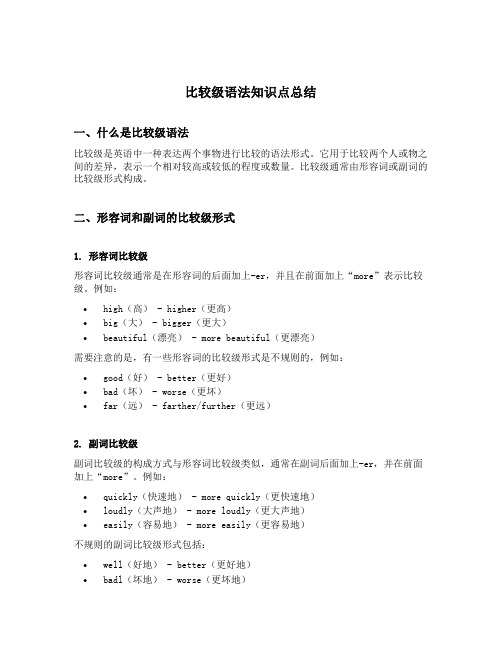
比较级语法知识点总结一、什么是比较级语法比较级是英语中一种表达两个事物进行比较的语法形式。
它用于比较两个人或物之间的差异,表示一个相对较高或较低的程度或数量。
比较级通常由形容词或副词的比较级形式构成。
二、形容词和副词的比较级形式1. 形容词比较级形容词比较级通常是在形容词的后面加上-er,并且在前面加上“more”表示比较级。
例如:•high(高) - higher(更高)•big(大) - bigger(更大)•beautiful(漂亮) - more beautiful(更漂亮)需要注意的是,有一些形容词的比较级形式是不规则的,例如:•good(好) - better(更好)•bad(坏) - worse(更坏)•far(远) - farther/further(更远)2. 副词比较级副词比较级的构成方式与形容词比较级类似,通常在副词后面加上-er,并在前面加上“more”。
例如:•quickly(快速地) - more quickly(更快速地)•loudly(大声地) - more loudly(更大声地)•easily(容易地) - more easily(更容易地)不规则的副词比较级形式包括:•well(好地) - better(更好地)•badl(坏地) - worse(更坏地)•far(远) - farther/further(更远地)三、比较级的用法1. 表示两个事物的比较比较级常用于比较两个事物的差异。
例如:•My car is faster than yours.(我的车比你的车快。
)•This book is more interesting than that one.(这本书比那本书更有趣。
)2. 表示递进关系比较级还可以用于表示递进关系,表示程度上的增加或减少。
例如:•The more you practice, the better you will become.(你练习得越多,你会变得越好。
人教版八年级上册英语语法、短语和知识点总结归纳

人教版八年级上册英语语法、短语和知识点总结归纳一、语法1. 一般现在时- 用法:表示经常性或惯性的动作或状态。
- 结构:主语 + 动词原形 (+ 其他成分)- 示例:I play soccer every weekend.2. 一般过去时- 用法:表示过去某个时间点或一段时间内发生的动作或存在的状态。
- 结构:主语 + 动词过去式 (+ 其他成分)- 示例:She watched a movie last night.3. 现在进行时- 用法:表示现在正在发生的动作。
- 结构:主语 + am/is/are + 动词-ing (+ 其他成分)- 示例:They are studying for the exam.4. 现在完成时- 用法:表示动作或状态发生在过去某个时间点,但与现在有关。
- 结构:主语 + have/has + 动词过去分词 (+ 其他成分)- 示例:I have finished my homework.5. 情态动词- 用法:表示能力、意愿、可能性等。
- 常见的情态动词有 can, could, may, might, must, should, ought to 等。
- 示例:He should go to bed early.二、短语1. as well as- 用法:表示两个事物同时存在或发生。
- 示例:She can speak English as well as Chinese.2. in order to- 用法:为了做某事。
- 示例:They woke up early in order to catch the train.3. by the way- 用法:用于引入一个新的话题或问题。
- 示例:By the way, have you seen the latest movie?三、知识点1. 直接引语和间接引语- 直接引语:用引号括起来的原话。
- 间接引语:将直接引语转述为陈述句或疑问句。
牛津译林版八年级英语全册语法知识点总结

1.句子结构:a.主语+谓语+宾语b.主语+谓语+间接宾语+直接宾语c.主语+谓语+宾语+宾语补足语d.主语+谓语+宾语+宾语补足语+定语e.主语+系动词+表语f.主语+不及物动词2.时态:a.一般现在时:表示现在经常性、习惯性的动作或状态。
b.现在进行时:表示现在正在进行的动作。
c.一般过去时:表示过去发生的动作或状态。
d.过去进行时:表示过去其中一时刻正在进行的动作。
e.一般将来时:表示将来的动作或状态。
f.将来进行时:表示将来其中一时刻正在进行的动作。
3.语态:a.主动语态:主语是动作的执行者。
b.被动语态:主语是动作的承受者。
4.动词时态和语态的被动形式:a. 一般现在时的被动形式:am/is/are+动词的过去分词。
b. 一般过去时的被动形式:was/were+动词的过去分词。
c. 将来时的被动形式:will be+动词的过去分词。
d. 现在进行时的被动形式:am/is/are+being+动词的过去分词。
e. 过去进行时的被动形式:was/were+being+动词的过去分词。
5.情态动词:a. can:表示能力、允许和请求。
b. may:表示许可、可能性和祝愿。
c. must:表示肯定、必要性和推测。
d. should:表示建议、责任和承诺。
e. might:表示推测、可能和祝愿。
f. would:表示假设、请求和习惯。
6.虚拟语气:a.虚拟语气用于表达虚构、假设、愿望、建议等。
b. 虚拟语气主要涉及以下几个时态:一般过去时、现在将来时、与现在相对的过去将来时、would/could+动词原形。
7.上文一致性:a.当主句用一般现在时态表述,宾语从句中的谓语动词将会保持不变。
b.当主句用过去时态表述,宾语从句中的谓语动词将用相应的过去时态。
总结完毕,以上是牛津译林版八年级英语全册所涉及的主要语法知识点。
高中语文语法部分知识点总结

一:高中语文语法基础知识概述:词类 高中语文语法之名词: 表示人和事物的名称的实词。如:"黄瓜、 白菜、拖拉机、计算机"。表示专用名称 的叫做"专用名词",如"云南、上海、李 白、白居易"。表示抽象事物的名称的叫 做"抽象名词",如"范畴、思想、质量、 品德、友谊、方法"。表示方位的叫做"方 位名词",如"上""下""左""右""前""后"" 中""东""西""南""北""前面""后边""东边"" 南面""中间"等。
高中语文语法之数词: 数词是表示事物数目的词。如"一、二、两、三、 七、十、百、千、万、亿、半"等。 高中语文语法之量词: 量词是表示事物或动作单位的词。汉语的量词分 为名量词和动量词。名量词表示事物的数量,又 可以分为单位量词和度量量词。单位量词表示事 物的单位,如“个、张、只、支、本、台、架、 辆、颗、株、头、间、把、扇”等;度量量词表 示事物的度量,如"寸、尺、丈、斤、两、吨、 升、斗、加仑、伏特、欧姆、立方米"。动量词 表示动作的数量,用在动词前后表示动作的单位, 如"次、下、回、趟、场"。
4、对比:强调了突出了 5、反复:强调了加强语气 语文语法归纳总结(三)句子含义的解答: 这样的题目,句子中往往有一个词语或短语用 了比喻、对比、借代、象征等表现方法。答题 时,把它们所指的对象揭示出来,再疏通句子, 就可以了。 语文语法归纳总结(四)某句话中某个词换成 另一个行吗?为什么? 动词:不行。因为该词准确生动具体地写出了 形容词:不行。因为该词生动形象地描写了
英语六年级语法知识点归纳

英语六年级语法知识点归纳英语六年级的语法知识点主要包括句子的基本结构、时态、语态、比较级和最高级、代词、形容词和副词、冠词、名词的单复数、动词的规则变化及不规则动词等。
下面将对这些知识点进行归纳总结。
1. 句子的基本结构英语句子由主语和谓语组成,且有时态和语态。
主语通常是名词或代词,谓语是动词或动词短语。
根据句子的语态,可以分为主动语态和被动语态。
2. 时态英语中有现在时、过去时和将来时。
现在时用于描述现在发生的动作或状态,过去时用于描述过去发生的动作或状态,将来时用于描述将来要发生的动作或状态。
3. 语态英语中的语态有主动语态和被动语态。
在主动语态中,主语是动作的执行者,而在被动语态中,主语是动作的接受者。
4. 比较级和最高级比较级用于表示两者之间的比较,最高级用于表示三者或三者以上的比较。
比较级的构成通常在形容词或副词前加上更或-er,最高级的构成通常在形容词或副词前加上最或-est。
5. 代词代词用于替代名词,常见的代词有人称代词、物主代词、指示代词、不定代词等。
6. 形容词和副词形容词用于修饰名词,副词用于修饰动词、形容词或其他副词。
形容词的比较级和最高级可以通过在后面加上-er和-est来构成,副词的比较级和最高级则通常在前面加上more和most。
7. 冠词英语中的冠词包括定冠词和不定冠词。
定冠词the用于特指某个人或物,不定冠词a/an用于泛指某个人或物。
8. 名词的单复数名词分为可数名词和不可数名词,可数名词有单数和复数两种形式,不可数名词只有单数形式。
复数名词的构成通常在单数名词后加上-s或-es。
9. 动词的规则变化及不规则动词动词根据时态和人称的不同,有时需要进行规则变化。
规则变化通常在动词原形后加上-s、-ed或-ing等。
但有一些动词是不规则的,它们的变化形式需要特别记忆。
这些就是英语六年级的语法知识点的基本归纳。
熟练掌握这些知识点,将有助于提高英语的语法水平,并在写作和口语表达中更准确地运用。
译林版九年级英语上册语法知识点总结

译林版九年级英语上册语法知识点总结1. 时态1.1 一般现在时- 表示经常性或惯性的动作。
- 表示普遍真理或事实。
1.2 一般过去时- 表示过去发生的事情。
- 表示过去惯性的动作。
1.3 一般将来时- 表示将来会发生的事情。
- 表示将来计划或打算做的事情。
2. 语态2.1 被动语态- 表示动作的承受者。
- 结构:be + 过去分词。
3. 情态动词3.1 情态动词表能力- can, could3.2 情态动词表可能性- may, might, must, can't3.3 情态动词表建议- should, should've, would, would've4. 句子结构4.1 简单句- 包含一个主语和一个谓语。
4.2 复合句- 包含两个或两个以上的简单句。
- 连接词:and, but, or, because, so, if, unless等。
4.3 并列句- 两个或两个以上的句子用并列连词连接。
- 并列连词:and, but, or等。
5. 疑问句5.1 一般疑问句- 是否疑问句:Do, Does, Did + 主语 + 谓语。
- 特殊疑问句:What, How, Why, Who, When, Where等 + 主语 + 谓语。
5.2 选择疑问句- 提供两个或两个以上的选项。
- 结构:Do, Does, Did + 主语 + 谓语 + 选项。
5.3 否定疑问句- 在肯定句后加上否定词。
- 结构:Do, Does, Did + 主语 + 谓语 + 否定词。
6. 祈使句- 表示命令、请求或建议。
- 结构:动词原形 / 动词原形 + 宾语。
7. 代词7.1 人称代词- I, you, he, she, it, we, they。
7.2 物主代词- my, your, his, her, its, our, their。
7.3 反身代词- myself, yourself, himself等。
比较级语法知识点总结

比较级语法知识点总结一、比较级的概念及用法比较级是英语中用来表示两个事物之间相对程度高低的形式,常用于比较两个事物的大小、数量、质量、速度等方面。
一般情况下,比较级由形容词或副词加上-er构成,或者在前面加more或less。
二、单音节和部分双音节形容词的比较级变化规则1. 以e结尾的单音节形容词,在后面直接加-r。
例如:large → larger, fine → finer2. 以辅音字母+y结尾的单音节形容词,把y改为i再加-er。
例如:happy → happier, funny → funnier3. 以重读闭音节结尾的单音节形容词,双写最后一个字母再加-er。
例如:big → bigger, hot → hotter4. 部分双音节形容词(重读在第一音节)也遵循以上规则。
例如:narrow → narrower, shallow → shallower三、多音节和不规则形容词的比较级变化规则1. 多音节形容词和部分双音节形容词(重读在第二或第三个音节)在前面加more表示比较级。
例如:interesting → more interesting, expensive → more expensive2. 不规则形容词的比较级变化需记忆。
例如:good → better, bad → worse四、比较级的用法1. 比较级常用于两个事物之间的比较。
例如:My house is bigger than yours.2. 用于表示一种变化趋势或程度的递增或递减。
例如:The weather is getting colder and colder.3. 用于表示对某个特定事物或情况的评价。
例如:This book is more interesting than that one.五、注意事项1. 当比较级前有限定词时,要注意其在句子中的位置。
例如:I have more books than he does.(more作为比较级)I have many more books than he does.(many作为限定词)2. 比较级常与than连用,表示“比……更……”。
九年级英语语法知识点归纳总结

九年级英语语法知识点归纳总结一、宾语从句宾语从句在复合句中作主句的宾语。
三大考点:引导词、时态和语序。
其中,语序必须是陈述句语序。
1. 常由下面的一些词引导:①由that 引导,表示陈述意义,that可省略He says (that) he is at home. 他说他在家里。
②由if , whether引导,表示一般疑问意义(带有是否、已否、对否等)I don’t know if / whether Wei Hua likes fish. 我不知道韦华是否喜欢鱼。
③由连接代词、连接副词(疑问词) 引导,表示特殊疑问意义Do you know what he wants to buy? 你知道他想要买什么吗?2. 从句时态要与主句一致当主句是一般现在时,从句根据情况使用任何时态当主句是一般过去时,从句应使用过去某时态(一般过去时,过去进行时,过去将来时,过去完成时)He said (that) he was at home. 他说他在家里。
I didn’t know that she was singing now. 我不知道她正在唱歌。
She wanted to know if I had finished m homewor k. 她想要知道我是否已经完成了我的作业。
Did you know when he would be back? 你知道他什么时候会回来吗?二、感叹句感叹句是表达喜、怒、哀、乐以及惊奇、惊讶等强烈感情的句子。
感叹句通常由what 或how 引导。
现分述如下:1. 由what 引导的感叹句,其句子结构可分为以下三种:①可用句型:“What +a / an+形容词+可数名词单数+主语+谓语+其他!”。
如:What a nice present it is! 它是一件多么好的礼物啊!②可用句型:“What+形容词+可数名词复数+主语+谓语+其他!”。
如:What beautiful flowers they are! 多么漂亮的花啊!③可用句型:“What +形容词+不可数名词+主语+谓语+其他!”如:What fine weather it is today! 今天天气多好啊!2. 由how 引导的感叹句,其句子结构也分为三种:①可用句型:“How +形容词/ 副词+主语+谓语+其他!”。
七年级下册英语语法知识点总结(一)

七年级下册英语语法知识点总结(一)七年级下册英语语法知识点总结前言作为一名资深的创作者,我深知语法对于英语学习的重要性。
掌握正确的语法知识不仅能提高我们的英语表达能力,还能帮助我们理解和阅读他人的英文文章。
在七年级下册的英语学习中,有一些重要的语法知识点需要我们掌握和应用。
接下来我将为大家总结这些知识点,希望能对大家的学习有所帮助。
正文以下是七年级下册英语语法知识点的总结:1. be动词的用法•be动词用于描述人或物的状态、身份、特征等。
•be动词根据主语的单数、复数和第三人称的不同形式有变化。
•be动词用于构成一般现在时、一般过去时等时态。
2. 一般现在时的构成和用法•一般现在时用于表达经常发生的动作、客观事实等。
•一般现在时的肯定句结构为:主语 + 动词原形。
•一般现在时的否定句结构为:主语 + do/does + not + 动词原形。
•一般现在时的疑问句结构为:Do/Does + 主语 + 动词原形 + 其他?3. be动词在一般现在时的用法•be动词在一般现在时的肯定句结构为:主语 + am/is/are。
•be动词在一般现在时的否定句结构为:主语 + am/is/are + not。
•be动词在一般现在时的疑问句结构为:am/is/are + 主语 + 其他?4. 一般过去时的构成和用法•一般过去时主要用于描述过去发生的动作或状态。
•一般过去时的肯定句结构为:主语 + 动词过去式。
•一般过去时的否定句结构为:主语 + did not + 动词原形。
•一般过去时的疑问句结构为:Did + 主语 + 动词原形 + 其他?5. be动词在一般过去时的用法•be动词在一般过去时的肯定句结构为:主语 + was/were。
•be动词在一般过去时的否定句结构为:主语 + was/were not。
•be动词在一般过去时的疑问句结构为:Was/Were + 主语 + 其他?•一般将来时用于描述将来要发生的动作或事件。
2024中考英语语法必考知识点总结

2024中考英语语法必考知识点总结一、时态1.一般现在时:表经常性的动作、习惯或客观事实。
2.一般过去时:表示过去发生、结束的动作或状态。
3.一般将来时:表示将来一些时间要发生的动作。
4.现在进行时:表示现在正在进行的动作。
5.过去进行时:表示过去其中一时刻或一段时间内正在进行的动作。
6.现在完成时:表示过去发生并与现在有关的动作或状态。
7.过去完成时:表示过去其中一动作或状态发生在另一过去动作或状态之前。
8. 一般将来时(be going to):表示将要、准备或打算做事。
二、被动语态1. 被动语态的构成:be + 过去分词2.主动语态和被动语态的转换:将主动语态的宾语变为主语,同时动词的形式改为被动语态的形式。
三、虚拟语气1.If从句中的虚拟语气:a)If从句表示与事实相反的情况,主句用过去将来时。
b)If从句表示与现在事实相反的情况,主句用过去时。
c) If从句表示与过去事实相反的情况,主句要用“had + 过去分词”。
2.虚拟条件句的其他情况:a) 与现在相反:as if, though, even if等引导的条件句,主句用过去时。
b)与将来相反:引导条件状语从句的主将从现,主句用过去时。
c)与过去相反:引导条件状语从句的主将从现,主句用过去完成时。
四、宾语从句1.宾语从句:在句子中作宾语的从句。
2.宾语从句的时态:按照实际情况使用时态。
3. 宾语从句的连接词:that, whether, if等。
五、定语从句1. 定语从句的构成:关系词(who, whom, whose, which, that)+句子。
2. 指物的定语从句:关系代词用which或that,在从句中充当主语、宾语或定语。
3. 指人的定语从句:关系代词用who或that,在从句中充当主语或宾语;关系代词用whom或that,在从句中充当宾语。
4. 定语从句的连接词从句中的位置:连接词(who, whom, which, that, whose)在从句中充当成分的位置。
十大英语语法基础知识点归纳总结

十大英语语法基础知识点归纳总结在学习英语的过程中,语法是一个非常重要的部分。
掌握好英语语法基础知识,不仅可以帮助我们正确地表达自己,还可以提高我们的英语水平。
下面,我将根据十大英语语法基础知识点,逐一进行总结和归纳,希望能够帮助大家更好地掌握这些知识。
1. 主谓一致主谓一致是指句子中的主语和谓语在人称和数上要保持一致。
在英语中,主谓一致是非常重要的语法规则,也是构成句子正确性的基础之一。
主语是第三人称单数时,谓语动词要加-s或-es。
2. 时态时态是表示动作或状态发生的时间的一种语法形式。
英语中有多种时态,包括一般现在时、一般过去时、一般将来时、现在进行时、过去进行时、将来进行时等。
掌握好各种时态的用法可以帮助我们准确地描述不同时间发生的动作或状态。
3. 名词复数名词复数是指表示两个或两个以上的个体、事物或概念的名词形式。
英语中名词复数的构成有规律可循,大多数名词在词尾加-s或-es就可以构成复数形式,但也有一些名词变化规律需要特别注意。
4. 冠词冠词是英语中用来限定名词的一种词类,包括定冠词“the”和不定冠词“a/an”。
冠词在句子中起着非常重要的限定作用,正确使用冠词可以让句子更加准确地表达出原意。
5. 代词代词是代替名词或名词词组的词语,用来避免重复或简化表达。
英语中的代词分为人称代词、物主代词、反身代词、指示代词、疑问代词、不定代词等多种类型,每种类型的代词都有着不同的用法和形式。
6. 动词时态和语态动词时态和语态是用来表示动作发生的时间和句子主语与谓语之间的关系。
英语中的动词时态包括一般现在时、一般过去时、一般将来时、现在进行时、过去进行时、将来进行时等,而语态则包括主动语态和被动语态。
7. 副词副词是用来修饰动词、形容词、副词或句子的成分,表示时间、地点、方式、原因、程度等。
在句子中,副词起着非常重要的修饰作用,可以让句子的表达更加生动和准确。
8. 介词介词是用来表示名词与其它词之间关系的一种虚词,包括表示时间、地点、方位、原因、目的等多种类型。
九年级所有语法知识点归纳

九年级所有语法知识点归纳在九年级的学习中,掌握和理解语法知识是非常重要的。
正确使用语法可以使我们的表达更加准确和清晰。
下面是九年级所有语法知识点的归纳总结。
一、词类归类1. 名词:用来表示人、事物、地点、概念等。
2. 代词:用来代替名词,包括人称代词、指示代词、疑问代词、不定代词等。
3. 形容词:用来修饰名词或代词,描述事物的特征和性质。
4. 动词:表示动作、状态或存在。
5. 副词:修饰动词、形容词、副词等,表示时间、地点、原因、程度等相关信息。
6. 介词:用来表示事物之间的关系,如时间、地点和方式等。
7. 连词:用来连接两个词、短语或句子,使语言连贯流畅。
8. 冠词:用来限定名词,分为不定冠词(a,an)和定冠词(the)。
9. 数词:用来表示数量,分为基数词和序数词。
10. 感叹词:用来表示情感、感叹或呼唤等。
二、句子结构1. 主语:句子的核心,通常是名词或代词,执行动作或被描述的人或事物。
2. 谓语:句子的谓语动词,表示主语的动作、状态或存在。
3. 宾语:接受动作的人或事物,通常是名词或代词。
4. 表语:指示主语的性质、特征或状态,通常是形容词或名词。
5. 定语:修饰名词或代词,描述其特征和性质,通常是形容词或名词。
6. 状语:修饰动词、形容词、副词等,表示时间、地点、方式、原因、程度等相关信息。
7. 补语:补充说明主语或宾语的性质、状态等,通常是形容词或名词。
三、句型概述1. 简单句:由一个主谓结构或主谓宾结构组成,表达一个完整的意思。
2. 并列句:由两个或多个简单句通过并列连词连接而成,表示并列关系。
3. 复合句:由一个主句和一个或多个从句构成,表示主从关系。
4. 疑问句:用来提问,可以通过改变句子语序或加上疑问词来构成。
5. 祈使句:用来表达请求、命令或建议等,通常省略主语。
6. 感叹句:表达强烈的感叹情感,常以感叹词开头。
四、时态和语态1. 一般现在时:表示经常性、习惯性或普遍真理。
初中英语语法知识点整理总结

初中英语语法知识点整理总结1.一般现在时一般现在时用来表示经常性的动作、事实或客观真理。
主语为第三人称单数时,动词要加s或es。
2.一般过去时一般过去时用来表示过去发生的事件或状态。
动词过去式有规则动词和不规则动词之分。
3.现在进行时现在进行时表示现在正在进行的动作,动词的变形为:am/is/are + 动词-ing。
4.现在完成时现在完成时表示过去发生的动作对现在造成的影响或结果。
动词的变形为:have/has + 过去分词。
5.一般将来时一般将来时用来表示将来发生的动作或存在的状态。
动词的变形为:will + 动词原形。
6.一般过去将来时一般过去将来时用来表示过去一些时间点之后本该发生但未发生的动作或情况。
动词的变形为:would + 动词原形。
7.动词不定式动词不定式用来表示一种动作或状态,或用作名词、定语或状语。
一般情况下,不定式前要加to。
8.动词的时态和语态英语动词的时态主要有三个:一般时、进行时和完成时。
动词的语态有两个:主动语态和被动语态。
9.定冠词和不定冠词定冠词the用来特指一些人或物,不定冠词a/an用来泛指一个人或物。
10.物主代词物主代词用来表示所有关系,如my, your, his, her, its, our, their等。
11.可数名词和不可数名词可数名词有单数和复数之分,不可数名词只有单数形式。
12.复数名词的变化规则复数名词一般在词尾加-s,以s,x,sh,ch结尾的名词在词尾加-es,以辅音字母+y结尾的名词变y为i再加-es。
13.形容词比较级和最高级形容词比较级用于比较两者,最高级用于比较三者或以上的事物。
14.形容词和副词的用法形容词修饰名词,副词修饰动词、形容词和副词。
15.介词的用法介词用于连接名词或代词与其他词,表示时间、地点、方向、原因等关系。
16.物主形容词和物主代词物主形容词用于修饰名词,物主代词用于代替名词。
17.反身代词反身代词用于强调一个人或物是动作的承受者或产生者。
新人教版九年级英语语法知识点全面总结
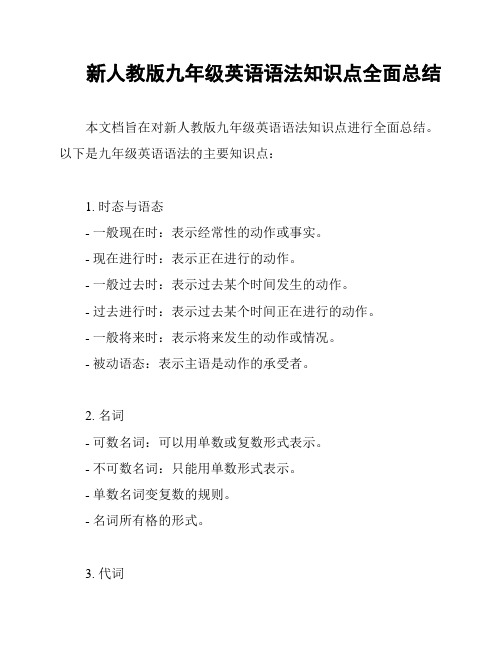
新人教版九年级英语语法知识点全面总结本文档旨在对新人教版九年级英语语法知识点进行全面总结。
以下是九年级英语语法的主要知识点:1. 时态与语态- 一般现在时:表示经常性的动作或事实。
- 现在进行时:表示正在进行的动作。
- 一般过去时:表示过去某个时间发生的动作。
- 过去进行时:表示过去某个时间正在进行的动作。
- 一般将来时:表示将来发生的动作或情况。
- 被动语态:表示主语是动作的承受者。
2. 名词- 可数名词:可以用单数或复数形式表示。
- 不可数名词:只能用单数形式表示。
- 单数名词变复数的规则。
- 名词所有格的形式。
3. 代词- 人称代词:主语形式、宾语形式、形容词性物主代词、名词性物主代词。
- 物主代词。
- 反身代词。
- 指示代词。
- 不定代词。
4. 冠词- 定冠词:the。
- 不定冠词:a、an。
5. 形容词与副词- 形容词的用法。
- 比较级与最高级。
- 副词的用法。
6. 介词与介词短语- 常见的介词及其用法。
- 介词短语在句子中的作用。
7. 数词与数量表达- 基数词与序数词。
- 百分数、分数与倍数的表达。
8. 动词及动词短语- 动词的时态与语态。
- 动词的非谓语形式:不定式、动名词、现在分词、过去分词。
- 动词的逻辑主语。
- 动词的短语搭配。
9. 句子成分分析- 主语与谓语。
- 宾语。
- 表语。
- 定语。
- 状语。
- 同位语。
- 补语。
- 状语从句。
- 主语从句。
- 宾语从句。
- 同位语从句。
以上是新人教版九年级英语语法知识点的全面总结。
希望对您有所帮助!。
2023最新-初三英语语法知识点总结归纳(优秀8篇)
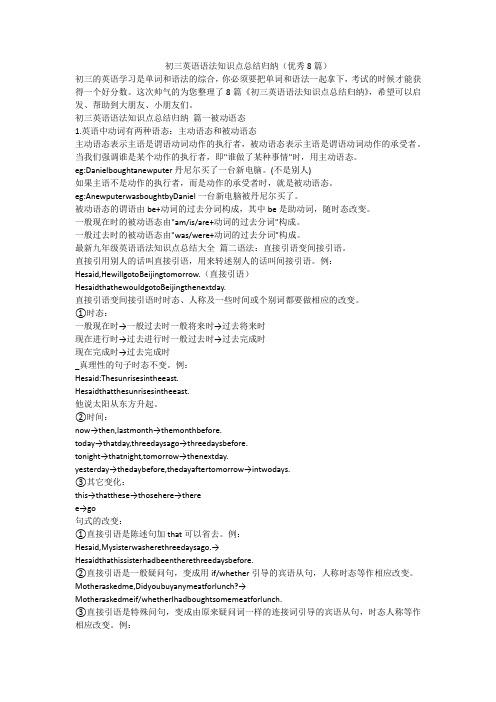
初三英语语法知识点总结归纳(优秀8篇)初三的英语学习是单词和语法的综合,你必须要把单词和语法一起拿下,考试的时候才能获得一个好分数。
这次帅气的为您整理了8篇《初三英语语法知识点总结归纳》,希望可以启发、帮助到大朋友、小朋友们。
初三英语语法知识点总结归纳篇一被动语态1.英语中动词有两种语态:主动语态和被动语态主动语态表示主语是谓语动词动作的执行者,被动语态表示主语是谓语动词动作的承受者。
当我们强调谁是某个动作的执行者,即"谁做了某种事情"时,用主动语态。
eg:Danielboughtanewputer丹尼尔买了一台新电脑。
(不是别人)如果主语不是动作的执行者,而是动作的承受者时,就是被动语态。
eg:AnewputerwasboughtbyDaniel一台新电脑被丹尼尔买了。
被动语态的谓语由be+动词的过去分词构成,其中be是助动词,随时态改变。
一般现在时的被动语态由"am/is/are+动词的过去分词"构成。
一般过去时的被动语态由"was/were+动词的过去分词"构成。
最新九年级英语语法知识点总结大全篇二语法:直接引语变间接引语。
直接引用别人的话叫直接引语,用来转述别人的话叫间接引语。
例:Hesaid,HewillgotoBeijingtomorrow.(直接引语)HesaidthathewouldgotoBeijingthenextday.直接引语变间接引语时时态、人称及一些时间或个别词都要做相应的改变。
①时态:一般现在时→一般过去时一般将来时→过去将来时现在进行时→过去进行时一般过去时→过去完成时现在完成时→过去完成时_真理性的句子时态不变。
例:Hesaid:Thesunrisesintheeast.Hesaidthatthesunrisesintheeast.他说太阳从东方升起。
②时间:now→then,lastmonth→themonthbefore.today→thatday,threedaysago→threedaysbefore.tonight→thatnight,tomorrow→thenextday.yesterday→thedaybefore,thedayaftertomorrow→intwodays.③其它变化:this→thatthese→thosehere→theree→go句式的改变:①直接引语是陈述句加that可以省去。
初中英语语法知识点的重要总结与归纳

初中英语语法知识点的重要总结与归纳初中英语语法是学习英语的基础,它涵盖了词法、句法、时态、语态等各个方面。
掌握了语法知识,可以帮助我们正确理解和使用英语,提高英语水平。
在本文中,我将对初中英语语法知识点进行重要总结与归纳。
一、词法知识点1. 名词:名词是指表示人、事物、地点、抽象概念等的词语。
可数名词有单数和复数形式,而不可数名词只有单数形式。
2. 形容词:形容词用来描述名词的特征和性质,它一般位于名词前面,修饰名词。
3. 动词:动词是表示行为、状态或存在的词语。
过去式和过去分词形式需要掌握。
4. 代词:代词用来代替名词,分为人称代词、物主代词、反身代词、指示代词等。
二、句法知识点1. 主语和谓语:一个句子中主语是执行动作的人或事物。
谓语是句子的核心部分,一般是表示行为或状态的动词。
2. 宾语:宾语是主语的动作所作用的对象或接收动作的人或物。
3. 定语:定语用来修饰名词或代词,通常位于被修饰的词的前面或后面。
4. 状语:状语是用来修饰动词、形容词、副词或整个句子的词语,它可以表示时间、地点、原因、方式等。
三、时态知识点1. 一般现在时:表示经常性、常规性的动作或状态。
例如:He eats an apple every day.2. 一般过去时:表示过去的经历、事情或状态。
例如:I watched a movie last night.3. 现在进行时:表示正在进行的动作。
例如:She is reading a book at the moment.4. 过去进行时:表示过去某个时间正在进行的动作。
例如:They were playing basketball yesterday.四、语态知识点1. 被动语态:被动语态是指动作的承受者成为句子的主语,动作的执行者通常不明确或不重要。
例如:The cake was eaten by them.2. 主动语态:主动语态是指动作的执行者作为句子的主语,动作的承受者通常作为宾语。
初中语法知识点总结
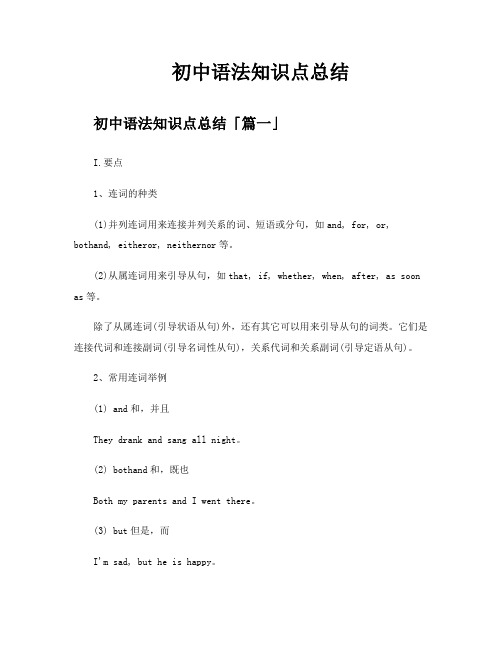
初中语法知识点总结初中语法知识点总结「篇一」I.要点1、连词的种类(1)并列连词用来连接并列关系的词、短语或分句,如and, for, or, bothand, eitheror, neithernor等。
(2)从属连词用来引导从句,如that, if, whether, when, after, as soon as等。
除了从属连词(引导状语从句)外,还有其它可以用来引导从句的词类。
它们是连接代词和连接副词(引导名词性从句),关系代词和关系副词(引导定语从句)。
2、常用连词举例(1) and和,并且They drank and sang all night。
(2) bothand和,既也Both my parents and I went there。
(3) but但是,而I'm sad, but he is happy。
(4) eitheror或或,要么要么Either you're wrong, or I am。
(5) for因为I asked him to stay, for I had something to tell him。
(6) however然而,可是At first, he didn't want to go there. Later, however, he decided to go。
(7) neithernor既不也不Neither my parents nor my aunt agrees with you。
(8) not onlybut(also)不但而且He not only sings well, but also dances well。
(9) or或者,否则Hurry up, or you'll be late。
Are you a worker or a doctor?(10) so因此,所以It's getting late, so I must go。
英语语法大全知识点总结
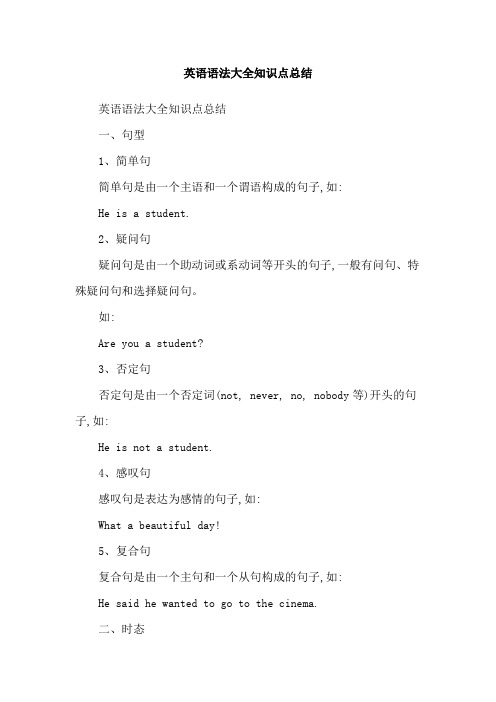
英语语法大全知识点总结
英语语法大全知识点总结
一、句型
1、简单句
简单句是由一个主语和一个谓语构成的句子,如:
He is a student.
2、疑问句
疑问句是由一个助动词或系动词等开头的句子,一般有问句、特殊疑问句和选择疑问句。
如:
Are you a student?
3、否定句
否定句是由一个否定词(not, never, no, nobody等)开头的句子,如:
He is not a student.
4、感叹句
感叹句是表达为感情的句子,如:
What a beautiful day!
5、复合句
复合句是由一个主句和一个从句构成的句子,如:
He said he wanted to go to the cinema.
二、时态
1、一般现在时
一般现在时是指表示一般性,经常性动作或事物的存在状态,如: He goes to school every day.
2、现在进行时
现在进行时是指表示正在进行或发生的动作,如:
He is playing football now.
3、一般过去时
一般过去时是指表示过去某个时间发生的动作或情况,如:
He went to school yesterday.
4、过去进行时
过去进行时是指表示过去某个时间正在发生的动作。
高级语法知识点总结
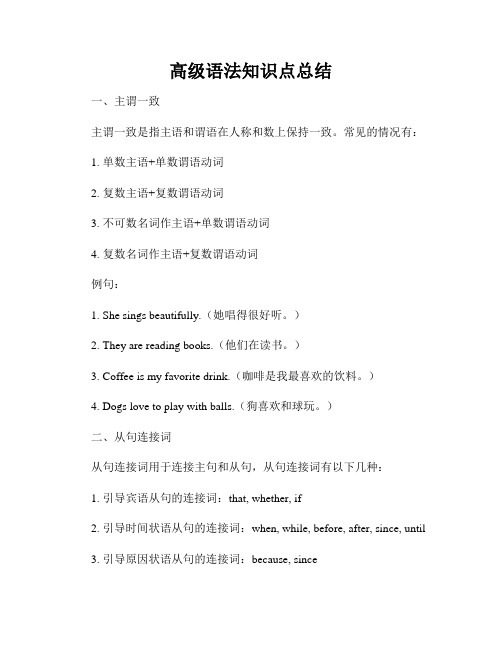
高级语法知识点总结一、主谓一致主谓一致是指主语和谓语在人称和数上保持一致。
常见的情况有:1. 单数主语+单数谓语动词2. 复数主语+复数谓语动词3. 不可数名词作主语+单数谓语动词4. 复数名词作主语+复数谓语动词例句:1. She sings beautifully.(她唱得很好听。
)2. They are reading books.(他们在读书。
)3. Coffee is my favorite drink.(咖啡是我最喜欢的饮料。
)4. Dogs love to play with balls.(狗喜欢和球玩。
)二、从句连接词从句连接词用于连接主句和从句,从句连接词有以下几种:1. 引导宾语从句的连接词:that, whether, if2. 引导时间状语从句的连接词:when, while, before, after, since, until3. 引导原因状语从句的连接词:because, since4. 引导条件状语从句的连接词:if, unless, provided that5. 引导目的状语从句的连接词:so that, in order that6. 引导结果状语从句的连接词:so...that, such...that例句:1. He said that he would come tomorrow.(他说他明天会来。
)2. I will call you when I arrive.(我到了会给你打电话。
)3. She failed the exam because she didn't study hard.(她没通过考试因为她没好好学习。
)4. If it rains, we will stay at home.(如果下雨,我们会待在家里。
)5. I bought some flowers so that I could decorate the room.(我买了一些花,这样我就能装饰房间了。
初一英语语法复习知识点总结
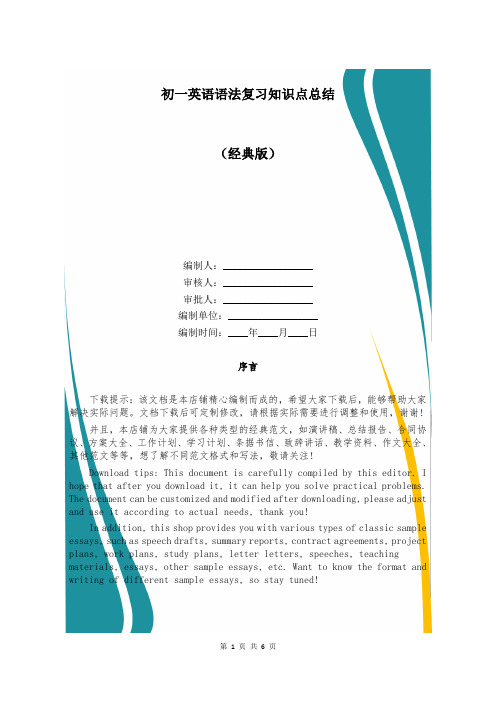
初一英语语法复习知识点总结(经典版)编制人:__________________审核人:__________________审批人:__________________编制单位:__________________编制时间:____年____月____日序言下载提示:该文档是本店铺精心编制而成的,希望大家下载后,能够帮助大家解决实际问题。
文档下载后可定制修改,请根据实际需要进行调整和使用,谢谢!并且,本店铺为大家提供各种类型的经典范文,如演讲稿、总结报告、合同协议、方案大全、工作计划、学习计划、条据书信、致辞讲话、教学资料、作文大全、其他范文等等,想了解不同范文格式和写法,敬请关注!Download tips: This document is carefully compiled by this editor. I hope that after you download it, it can help you solve practical problems. The document can be customized and modified after downloading, please adjust and use it according to actual needs, thank you!In addition, this shop provides you with various types of classic sample essays, such as speech drafts, summary reports, contract agreements, project plans, work plans, study plans, letter letters, speeches, teaching materials, essays, other sample essays, etc. Want to know the format and writing of different sample essays, so stay tuned!初一英语语法复习知识点总结虽然我们是到了初一才开始正式学习英语语法,但是初一要掌握的语法知识还是挺多的,下面是本店铺为大家整理的初一英语语法知识点,希望对大家有所帮助。
- 1、下载文档前请自行甄别文档内容的完整性,平台不提供额外的编辑、内容补充、找答案等附加服务。
- 2、"仅部分预览"的文档,不可在线预览部分如存在完整性等问题,可反馈申请退款(可完整预览的文档不适用该条件!)。
- 3、如文档侵犯您的权益,请联系客服反馈,我们会尽快为您处理(人工客服工作时间:9:00-18:30)。
四级语法知识点总结一:时态:所谓的"时态",就是时间+状态。
谓语动词的时态见下表: 1.主动形式 2.被动形式CET-4 常考的三种时态:过去完成时;将来完成时;(现在/过去)完成进行时。
时间状语从句当中的时态:一般过去时 所有的过去用 一般现在时 表示 现在和将来现在完成时 现在完成和将来完成过去 现在 将来 过去将来 一般did do will/shall do should/would do 进行was/were doing am/is/are doing will/shall be doing / 完成 had done have/has done will/shall havedoneshould/would have done 用于虚拟语气 完成进行had been doing have/has been doing / /过去 现在 将来 过去将来 一般was/were given am/is/are given will/shall be given should/would be given 进行was/were being given am/is/are being given / / 完成 had been given have/has been given will/shall have been given should/wouldhave been given完成进行 // /二:非谓语动词1.不定式:一)不定式的常考形式:1)一般形式:He decided to work harder in order to catch up withthe others.被动形式: He preferred to be assigned some heavier work to do.语法功能:表示与谓语动词同步发生2)完成形式:He pretended not to have seen me.被动形式:The book is said to have been translated into many languages.语法功能:表示发生在谓语动词之前二)不定式常考的考点:1)不定式做定语----将要发生2)不定式做状语----目的3)不定式充当名词功能---To see is to believe.三)不定式的省略感官动词 see, watch, observe, notice, look at, hear, listen to, smell, taste, feel+ do 表示动作的完整性,真实性;+ doing表示动作的连续性,进行性I saw him work in the garden yesterday.昨天我看见他在花园里干活了。
(强调"我看见了"这个事实)I saw him working in the garden yesterday.昨天我见他正在花园里干活。
(强调"我见他正干活"这个动作)感官动词后面接形容词而不是副词:The cake tastes good; Itfeels comfortable.使役动词 have bid make let 等词后不定式要省略但同1)一样被动以后要还原toI ‘d like to have John do it.I have my package weighed.Paul doesn’t have to be made to learn.help help sb do help sb to do help do help to do四)有些动词后只跟不定式如:want,wish,hope,manage,promise,refuse,pretend,plan,offer,decide,agree,expect allow sb to do, cause sb to do , permit sb to do, enable sb to doforce sb to do. be more likely to do love to do warn sb to do be able to dobe ambitious to do. begin to do . start to do五) 有的时候to后面要接-ing形式accustom (oneself) to; be accustomed to; face up to; in addition to; look forward to; object to; be reduced to; resign oneself to; be resigned to; resort to; sink to; be used to; be alternative to; be close/closeness to; be dedication/dedicated to; be opposition/opposed to; be similarity/similar to.2. 动名词:具有动作性特征的名词1)是名词 seeing is believing2)具有动词性特征可以带宾语 starving troops is necessary.一)动名词的形式:一般形式:I don't like you smoking.完成形式:I regret not having taken your advice.被动形式:This question is far from being settled.二) 动名词常考的点1)动名词做主语谓语动词为单数2)在动名词和不定式中,做为介词的宾语是动名词3)动名词的否定直接在其前加否定词,通过代词的宾格或所有格形式给出逻辑主语.I would appreciate_______ back this afternoon.A.you to call B.you call C.you calling D.you're calling (Key:C your calling 也对)I regret not having taken your advice.4)有些词后只能接动名词admit; appreciate; avoid; celebrate; consider; contemplate; defer; delay; deny; detest; discontinue; dislike; dispute; enjoy; it entails; escape; excuse; explain; fancy; feel like; finish; forgive; can't help; hinder; imagine; it involves; keep; it means; mention; mind; miss; it necessitates; pardon; postpone; practice; prevent; recall; report; resent; resist; risk; suggest; understand...另外还有一些接-ing形式的常用说法:it's no good; it's no/little/hardly any/ use; it'snot/hardly/scarcely use; it's worthwhile; spend money/time; there's no; there's no point in; there's nothing worse than; what's theuse/point...5)有些词后加不定式和动名词均可remember, forget, try, stop, go on, cease, mean后面用不定式和-ing形式,意义截然不容。
I remembered to post the letters. (指未来/过去未来的动作)I remembered posting/having posting the letters (我记得这个动作)forgot与remember的用法类似。
I regret to inform you tha t… 我很遗憾地通知你…I regretted having left the firm after twenty years. 为了"二十年前的离开"而遗憾。
try to 努力 You really must try to overcome your shyness.try –ing 试验Try practicing five hours a day.I mean to go, but my father would not allow me to. [打算、想]我想去,但我父亲不让我去。
To raise wage means increasing purchasing power. [意味着]赠加工资意味着增加购买力。
prefer的用法:我宁愿在这里等。
I prefer to wait here. (所以啊,你不介意的话,我就等下去。
)I prefer waiting here.(我正在这里等,我就喜欢这么做。
)I prefer swimming to cycling. (这个句子里面就不能用不定式了。
)3 分词:现在分词主动进行,过去分词被动状态现在分词的形式:1)一般式: Do you see the man talking to the dean(主任)?(与谓语动词同步发生)2)完成形式:Not having made adequate preparations, they failed.(发生谓语动词之前)3)完成被动形式:Having been adapted, the script seems perfect.(发生谓语动词之前且表示被动)过去分词1)过去分词表示被动:Fight no battle unprepared.2)过去分词的进行形式:You'll find the topic being discussed everywhere. (强调正在被做)这三种非谓语动词,都可以构成复合结构,非谓语动词所修饰的成分是这些非谓语动词的逻辑主语。
他们之间的一致关系——主动还是被动,往往就是考点。
独立主格结构中,要注意的是分词与他前面的逻辑主语之间的主动被动的关系。
三:虚拟语气情态动词所表达的可能性程度:must/can't should/shouldn't might/may (not)另外两个"类情态词的形式:"need/needn't; have to/don't have to 最自然的虚拟状态:由should/would+原型时态(不含时间只含状态)本质上是过去将来时:即,时间固定在过去将来,状态不同:一般、进行、完成、完成进行。
